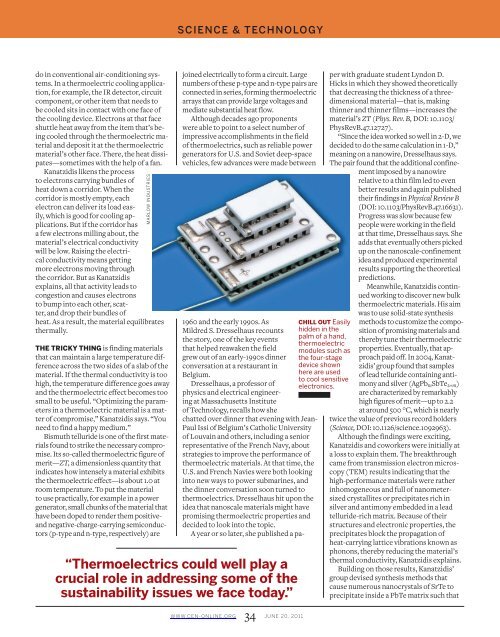June 20, 2011 - IMM@BUCT
June 20, 2011 - IMM@BUCT
June 20, 2011 - IMM@BUCT
Create successful ePaper yourself
Turn your PDF publications into a flip-book with our unique Google optimized e-Paper software.
SCIENCE & TECHNOLOGYdo in conventional air-conditioning systems.In a thermoelectric cooling application,for example, the IR detector, circuitcomponent, or other item that needs tobe cooled sits in contact with one face ofthe cooling device. Electrons at that faceshuttle heat away from the item that’s beingcooled through the thermoelectric materialand deposit it at the thermoelectricmaterial’s other face. There, the heat dissipates—sometimeswith the help of a fan.Kanatzidis likens the processto electrons carrying bundles ofheat down a corridor. When thecorridor is mostly empty, eachelectron can deliver its load easily,which is good for cooling applications.But if the corridor hasa few electrons milling about, thematerial’s electrical conductivitywill be low. Raising the electricalconductivity means gettingmore electrons moving throughthe corridor. But as Kanatzidisexplains, all that activity leads tocongestion and causes electronsto bump into each other, scatter,and drop their bundles ofheat. As a result, the material equilibratesther mally.THE TRICKY THING is finding materialsthat can maintain a large temperature differenceacross the two sides of a slab of thematerial. If the thermal conductivity is toohigh, the temperature difference goes awayand the thermoelectric effect becomes toosmall to be useful. “Optimizing the parametersin a thermoelectric material is a matterof compromise,” Kanatzidis says. “Youneed to find a happy medium.”Bismuth telluride is one of the first materialsfound to strike the necessary compromise.Its so-called thermoelectric figure ofmerit— ZT, a dimensionless quantity thatindicates how intensely a material exhibitsthe thermoelectric effect—is about 1.0 atroom temperature. To put the materialto use practically, for example in a powergenerator, small chunks of the material thathave been doped to render them positiveandnegative-charge-carrying semiconductors(p-type and n-type, respectively) areMARLOW INDUSTRIESjoined electrically to form a circuit. Largenumbers of these p-type and n-type pairs areconnected in series, forming thermoelectricarrays that can provide large voltages andmediate substantial heat flow.Although decades ago proponentswere able to point to a select number ofimpressive accomplishments in the fieldof thermoelectrics, such as reliable powergenerators for U.S. and Soviet deep-spacevehicles, few advances were made between“Thermoelectrics could well play acrucial role in addressing some of thesustainability issues we face today.”WWW.CEN-ONLINE.ORG 34 JUNE <strong>20</strong>, <strong>20</strong>11CHILL OUT Easilyhidden in thepalm of a hand,thermoelectricmodules such asthe four-stagedevice shownhere are usedto cool sensitiveelectronics.1960 and the early 1990s. AsMildred S. Dresselhaus recountsthe story, one of the key eventsthat helped reawaken the fieldgrew out of an early-1990s dinnerconversation at a restaurant inBelgium.Dresselhaus, a professor ofphysics and electrical engineeringat Massachusetts Instituteof Technology, recalls how shechatted over dinner that evening with Jean-Paul Issi of Belgium’s Catholic Universityof Louvain and others, including a seniorrepresentative of the French Navy, aboutstrategies to improve the performance ofthermoelectric materials. At that time, theU.S. and French Navies were both lookinginto new ways to power submarines, andthe dinner conversation soon turned tothermoelectrics. Dresselhaus hit upon theidea that nanoscale materials might havepromising thermoelectric properties anddecided to look into the topic.A year or so later, she published a paperwith graduate student Lyndon D.Hicks in which they showed theoreticallythat decreasing the thickness of a threedimensionalmaterial—that is, makingthinner and thinner films—increases thematerial’s ZT ( Phys. Rev. B, DOI: 10.1103/PhysRevB.47.12727).“Since the idea worked so well in 2-D, wedecided to do the same calculation in 1-D,”meaning on a nanowire, Dresselhaus says.The pair found that the additional confinementimposed by a nanowirerelative to a thin film led to evenbetter results and again publishedtheir findings in Physical Review B(DOI: 10.1103/PhysRevB.47.16631).Progress was slow because fewpeople were working in the fieldat that time, Dresselhaus says. Sheadds that eventually others pickedup on the nanoscale-confinementidea and produced experimentalresults supporting the theoreticalpredictions.Meanwhile, Kanatzidis continuedworking to discover new bulkthermoelectric materials. His aimwas to use solid-state synthesismethods to customize the compositionof promising materials andthereby tune their thermoelectricproperties. Eventually, that approachpaid off. In <strong>20</strong>04, Kanatzidis’group found that samplesof lead telluride containing antimonyand silver (AgPb m SbTe 2+ m )are characterized by remarkablyhigh figures of merit—up to 2.2at around 500 °C, which is nearlytwice the value of previous record holders( Science, DOI: 10.1126/science.1092963).Although the findings were exciting,Kanatzidis and coworkers were initially ata loss to explain them. The breakthroughcame from transmission electron microscopy(TEM) results indicating that thehigh-performance materials were ratherinhomogeneous and full of nanometersizedcrystallites or precipitates rich insilver and antimony embedded in a leadtelluride-rich matrix. Because of theirstructures and electronic properties, theprecipitates block the propagation ofheat-carrying lattice vibrations known asphonons, thereby reducing the material’sthermal conductivity, Kanatzidis explains.Building on those results, Kanatzidis’group devised synthesis methods thatcause numerous nanocrystals of SrTe toprecipitate inside a PbTe matrix such that
















